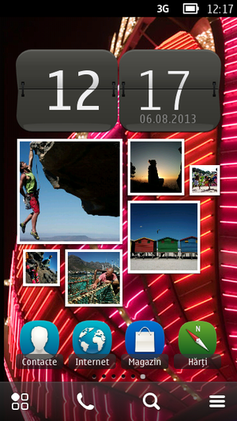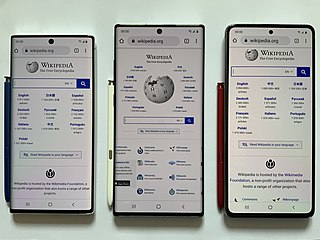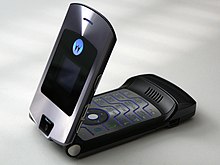
A smartphone is a mobile device that combines the functionality of a traditional mobile phone with advanced computing capabilities. It typically has a touchscreen interface, allowing users to access a wide range of applications and services, such as web browsing, email, and social media, as well as multimedia playback and streaming. Smartphones have built-in cameras, GPS navigation, and support for various communication methods, including voice calls, text messaging, and internet-based messaging apps.
Sony Mobile Communications Inc. was a multinational telecommunications company founded on October 1, 2001, as a joint venture between Sony Corporation and Ericsson. It was originally incorporated as Sony Ericsson Mobile Communications, and headquartered in London, England, until Sony acquired Ericsson's share in the venture on February 16, 2012. On April 1, 2021, Sony integrated its electronics businesses including Sony Mobile into one company called Sony Corporation.

Windows Mobile is a discontinued mobile operating system developed by Microsoft for smartphones and personal digital assistants.

Motorola Mobility LLC, marketed as Motorola, is an American consumer electronics manufacturer primarily producing smartphones and other mobile devices running Android. Headquartered at Merchandise Mart in Chicago, Illinois, it is a subsidiary of the Chinese technology company Lenovo.
The usage share of an operating system is the percentage of computers that run that operating system (OS). These statistics are estimates as wide scale OS usage data is difficult to obtain and measure. Reliable primary sources are limited and data collection methodology is not formally agreed. Currently devices connected to the internet allow for web data collection to approximately measure OS usage.
Android is a mobile operating system based on a modified version of the Linux kernel and other open-source software, designed primarily for touchscreen mobile devices such as smartphones and tablets. Android is developed by a consortium of developers known as the Open Handset Alliance, though its most widely used version is primarily developed by Google. It was unveiled in November 2007, with the first commercial Android device, the HTC Dream, being launched in September 2008.
A mobile operating system is an operating system used for smartphones, tablets, smartwatches, smartglasses, or other non-laptop personal mobile computing devices. While computers such as typical/mobile laptops are "mobile", the operating systems used on them are generally not considered mobile, as they were originally designed for desktop computers that historically did not have or need specific mobile features. This line distinguishing mobile and other forms has become blurred in recent years, due to the fact that newer devices have become smaller and more mobile unlike hardware of the past. Key notabilities blurring this line are the introduction of tablet computers, light laptops, and the hybridization of the two in 2-in-1 PCs.

Windows Phone (WP) is a discontinued mobile operating system developed by Microsoft for smartphones as the replacement successor to Windows Mobile and Zune. Windows Phone featured a new user interface derived from the Metro design language. Unlike Windows Mobile, it was primarily aimed at the consumer market rather than the enterprise market.

A mobile phone is a portable telephone that can make and receive calls over a radio frequency link while the user is moving within a telephone service area, as opposed to a fixed-location phone. The radio frequency link establishes a connection to the switching systems of a mobile phone operator, which provides access to the public switched telephone network (PSTN). Modern mobile telephone services use a cellular network architecture, and therefore mobile telephones are called cellphones in North America. In addition to telephony, digital mobile phones support a variety of other services, such as text messaging, multimedia messaging, email, Internet access, short-range wireless communications, satellite access, business applications, payments, multimedia playback and streaming, digital photography, and video games. Mobile phones offering only basic capabilities are known as feature phones ; mobile phones that offer greatly advanced computing capabilities are referred to as smartphones.

Symbian is a discontinued mobile operating system (OS) and computing platform designed for smartphones. It was originally developed as a proprietary software OS for personal digital assistants in 1998 by the Symbian Ltd. consortium. Symbian OS is a descendant of Psion's EPOC, and was released exclusively on ARM processors, although an unreleased x86 port existed. Symbian was used by many major mobile phone brands, like Samsung, Motorola, Sony Ericsson, and above all by Nokia. It was also prevalent in Japan by brands including Fujitsu, Sharp and Mitsubishi. As a pioneer that established the smartphone industry, it was the most popular smartphone OS on a worldwide average until the end of 2010, at a time when smartphones were in limited use, when it was overtaken by iOS and Android. It was notably less popular in North America.
Micromax Informatics is an Indian multinational manufacturer of consumer electronics and home appliances, headquartered in Gurugram. It was established in March 2000 as an IT software company operating in embedded systems. It entered the mobile phone business in 2008 and, by 2010, became one of the largest companies making low-cost feature phones in India.

Lenovo smartphones are marketed as the "LePhone" in Mainland China and the "IdeaPhone" overseas are smartphones designed and manufactured by the Motorola Mobility, ZUK Mobile and Medion, divisions of Lenovo. On April 27, 2017, Lenovo announced that the ZUK brand would cease operations. In 2015, Lenovo subsumed its own smartphone division into the acquired Motorola brand.

Microsoft Lumia is a discontinued line of mobile devices that was originally designed and marketed by Nokia and later by Microsoft Mobile. Introduced in November 2011, the line was the result of a long-term partnership between Nokia and Microsoft—as such, Lumia smartphones run on Microsoft software, the Windows Phone operating system; and later the newer Windows 10 Mobile. The Lumia name is derived from the partitive plural form of the Finnish word lumi, meaning "snow".
HTC One is a series of Android and Windows Phone smartphones designed and manufactured by HTC. All products in the One series were designed to be touchscreen-based and slate-sized, and to initially run the Android mobile operating system with the HTC Sense graphical user interface. The one exception to this is the HTC One (M8), which also had a Windows Phone variant. From 2010 to 2013, all HTC products starting from the HTC Sensation XE to the HTC One Mini were equipped with a Beats Audio equalizer. Later HTC devices beginning with the HTC One Max no longer ship with Beats Audio following the buyback of HTC's stake in Beats Electronics.

A phablet is a mobile device combining or straddling the size formats of smartphones and tablets. The word is a portmanteau of phone and tablet. The term is largely obsolete by the late 2010s, since average smartphone sizes eventually morphed into small tablet sizes, up to 6.9 inches (180 mm), with wider aspect ratios.

Microsoft Mobile Oy was a subsidiary of Microsoft involved in the development and manufacturing of mobile phones. Based in Espoo, Finland, it was established in 2014 following the acquisition of Nokia's Devices and Services division by Microsoft in a deal valued at €5.4 billion, which was completed in April 2014. Nokia's then-CEO, Stephen Elop, joined Microsoft as president of its Devices division following the acquisition, and the acquisition was part of Steve Ballmer's strategy to turn Microsoft into a "devices and services" company. Under a 10-year licensing agreement, Microsoft Mobile held rights to sell feature phones running the S30/S30+ platform under the Nokia brand.

Redmi is a subsidiary company owned by the Chinese electronics company Xiaomi. It was first announced in July 2013 as a budget smartphone line, and became a separate sub-brand of Xiaomi in 2019 with entry-level and mid-range devices, while Xiaomi itself produces upper-range and flagship Xiaomi phones.

Human Mobile Devices (HMD), formally HMD Global, is a Finnish mobile phone manufacturer. The company is made up of the mobile phone business that the Nokia Corporation sold to Microsoft in 2014, then bought back in 2016. HMD began marketing Nokia-branded smartphones and feature phones on 1 December 2016. The company has exclusive rights to the Nokia brand for mobile phones through a licensing agreement. The HMD brand was initially only used for corporate purposes and does not appear in advertising, whereas the name "Nokia Mobile" is used on social media. As it was launched, the acronym HMD stood for Hon Hai Mobile Devices. This was in reference to the main shareholder at the time of its creation: the Taiwanese group Foxconn. In January 2024, HMD rebranded to 'Human Mobile Devices', and will use their own branding on future devices alongside that of Nokia.














